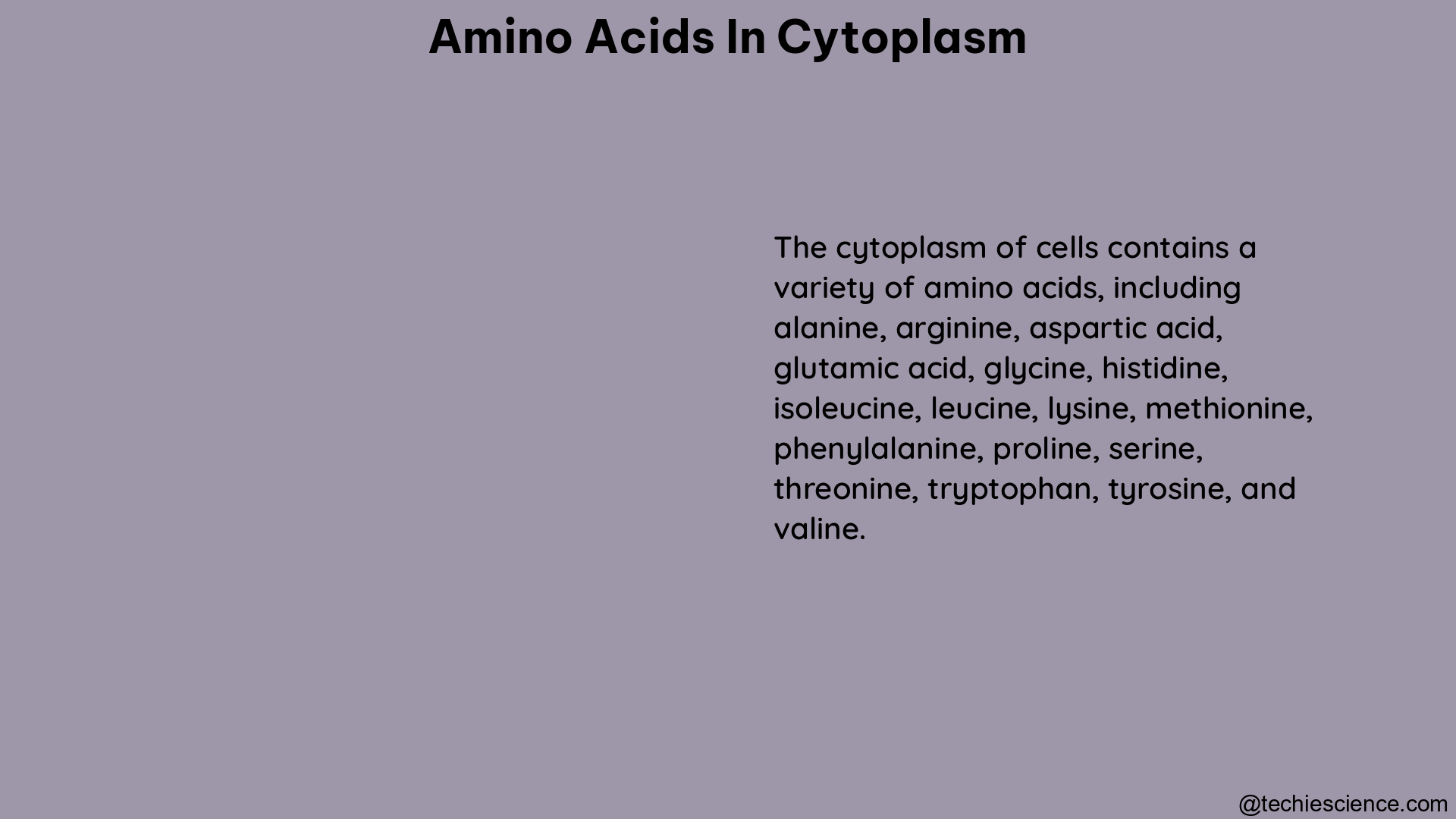Amino acids in the cytoplasm play a crucial role in various cellular processes, including protein synthesis, energy metabolism, and signaling pathways. The concentration and composition of cytoplasmic amino acids are tightly regulated and can provide valuable insights into cellular physiology and pathology.
Understanding the Cytoplasmic Amino Acid Pool
The cytoplasmic pool of amino acids is a dynamic and complex system that serves multiple functions within the cell. This pool is not solely dedicated to protein synthesis but also plays a broader role in cellular metabolism, acting as precursors for the synthesis of nucleotides, nucleic acids, methylene tetra-hydrofolate, complex lipids, and energy substrates.
Amino Acid Composition and Environmental Conditions
One study investigated the changes in the cytoplasmic composition of amino acids and ribosomal proteins in bacteria under various environmental conditions. The researchers used principal component analysis (PCA) to analyze the data and made several key observations:
- Diverse Metabolic Roles: The cytoplasmic pool of amino acids did not solely service protein synthesis but had broader roles in cellular metabolism.
- Environmental Adaptations: The biological replicates were tightly clustered depending on the environmental conditions for growth, indicating high reproducibility within replicates and characteristic amino acid profile compositions between treatments.
- Metabolic Flexibility: The cytoplasmic amino acid pool demonstrated the ability to adapt to different environmental conditions, highlighting the metabolic flexibility of bacteria.
Amino Acid Homeostasis in Human Cells
Another study modeled amino acid homeostasis in primary human myotubes (muscle cells) using transport activities proportional to mRNA expression. The simulation correlated well with the experimental data, reaching a Pearson’s R of 0.97 at t= 0.25 h and t= 2 h. The modeling revealed that the relationship between extracellular and intracellular amino acid concentrations was determined by transport processes, and the dynamics of the system were replicated well for media inducing inflammation in muscle.
This study highlights the importance of understanding amino acid homeostasis in human cells, as it can provide insights into the regulation of cellular processes and the potential impact of environmental factors, such as inflammation, on amino acid metabolism.
Amino Acid Analysis: A Fundamental Biochemical Technique

Amino acid analysis is a fundamental biochemical technique used for the determination of the amino acid composition or content of proteins, peptides, and other pharmaceutical or biological preparations or samples containing compounds that contain primary or secondary amino groups within their molecular structure.
Applications of Amino Acid Analysis
- Protein Characterization: Amino acid analysis enables the analysis of protein complexes or mixtures of proteins, such as protein powder supplements. It can provide information on protein characterization, concentration, content, molar ratio, and extinction coefficients.
- Pharmaceutical and Biological Preparations: Amino acid analysis is used to analyze the amino acid composition or content of various pharmaceutical and biological preparations, including proteins, peptides, and other compounds containing amino groups.
- Metabolic Profiling: Analyzing the cytoplasmic amino acid composition can provide insights into cellular metabolism and the impact of environmental factors on amino acid homeostasis.
- Nutritional Assessment: Amino acid analysis can be used to assess the nutritional value and quality of food and feed products, as well as to detect potential adulterations or contaminations.
Analytical Techniques for Amino Acid Analysis
Several analytical techniques are commonly used for amino acid analysis, including:
- High-Performance Liquid Chromatography (HPLC): HPLC is a widely used technique for the separation, identification, and quantification of amino acids in various samples.
- Gas Chromatography-Mass Spectrometry (GC-MS): GC-MS is another powerful technique that can provide detailed information on the amino acid composition of samples.
- Capillary Electrophoresis (CE): CE is a high-resolution separation technique that can be used for the analysis of amino acids in complex samples.
- Enzymatic Assays: Specific enzymatic assays can be used to quantify the levels of individual amino acids in biological samples.
The choice of analytical technique depends on factors such as the sample matrix, the required sensitivity, and the specific information needed.
Conclusion
Amino acids in the cytoplasm play a vital role in cellular processes, serving as building blocks for proteins, precursors for various metabolic pathways, and regulators of cellular signaling. Understanding the composition and dynamics of the cytoplasmic amino acid pool can provide valuable insights into cellular physiology and pathology, as well as inform the development of targeted interventions and therapeutic strategies.
Amino acid analysis is a fundamental biochemical technique that enables the characterization, quantification, and identification of amino acids in a wide range of biological and pharmaceutical samples. This powerful analytical tool can be applied to diverse areas, from protein characterization and nutritional assessment to metabolic profiling and the study of cellular homeostasis.
By delving deeper into the intricacies of cytoplasmic amino acids, researchers and clinicians can unlock new avenues for understanding and manipulating cellular processes, ultimately leading to advancements in fields such as biotechnology, medicine, and nutrition.
References:
- Changes in the Cytoplasmic Composition of Amino Acids and Ribosomal Proteins in Bacteria under Various Environmental Conditions. Link
- Quantitative Modeling of Amino Acid Transport and Homeostasis in a Medically Relevant Cell Model. Link
- Amino Acid Analysis (Quantification & Identification). Link

Hello, I am Sugaprabha Prasath, a Postgraduate in the field of Microbiology. I am an active member of the Indian association of applied microbiology (IAAM). I have research experience in preclinical (Zebrafish), bacterial enzymology, and nanotechnology. I have published 2 research articles in an International journal and a few more are yet to be published, 2 sequences were submitted to NCBI-GENBANK. I am good at clearly explaining the concepts in biology at both basic and advanced levels. My area of specialization is biotechnology, microbiology, enzymology, molecular biology, and pharmacovigilance. Apart from academics, I love gardening and being with plants and animals.
My LinkedIn profile-